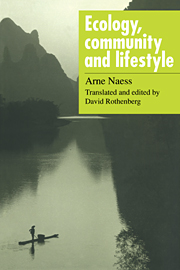Book contents
- Frontmatter
- Contents
- Translator's preface
- Introduction: Ecosophy T – from intuition to system
- 1 The environmental crisis and the deep ecological movement
- 2 From ecology to ecosophy
- 3 Fact and value; basic norms
- 4 Ecosophy, technology, and lifestyle
- 5 Economics within ecosophy
- 6 Ecopolitics within ecosophy
- 7 Ecosophy T: unity and diversity of life
- Bibliography
- Index
2 - From ecology to ecosophy
Published online by Cambridge University Press: 13 October 2009
- Frontmatter
- Contents
- Translator's preface
- Introduction: Ecosophy T – from intuition to system
- 1 The environmental crisis and the deep ecological movement
- 2 From ecology to ecosophy
- 3 Fact and value; basic norms
- 4 Ecosophy, technology, and lifestyle
- 5 Economics within ecosophy
- 6 Ecopolitics within ecosophy
- 7 Ecosophy T: unity and diversity of life
- Bibliography
- Index
Summary
The first part of the chapter introduces a way of formulating the essential traits of a total view which could be of help to all who wish to verbalise their basic attitudes and compare them with others' – especially those who seem to oppose vigorous ecological policies. This portion is methodological, and not limited to my own particular view, Ecosophy T.
The second part attacks problems of ontology, ‘what there is’. Rather than talking about reality or the world, ecophilosophical thinking proceeds in terms of nature, and humanity's relation to nature. An attempt is made to defend our spontaneous, rich, seemingly contradictory experience of nature as more than subjective impressions. They make up the concrete contents of our world. This point of view, as every other ontology, is deeply problematic – but of great potential value for energetic environmentalism in its opposition to the contemporary near monopoly of the so-called scientific world-view.
The terms ecology, ecophilosophy, ecosophy
Those who come across these three terms should ask for precise definitions – but in the disorderly terminological situation we are placed in today, both descriptive and prescriptive definitions are somewhat arbitrary. In this work, the three words will have three very distinct meanings adapted to our purpose. Others, however, with other purposes, may disagree somewhat on these precise meanings.
- Type
- Chapter
- Information
- Ecology, Community and LifestyleOutline of an Ecosophy, pp. 35 - 67Publisher: Cambridge University PressPrint publication year: 1989



